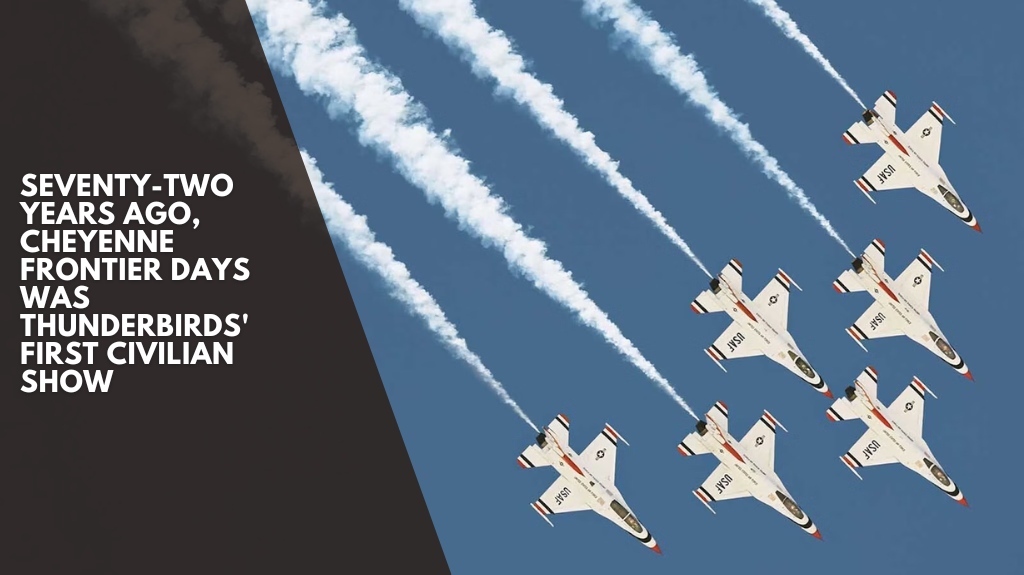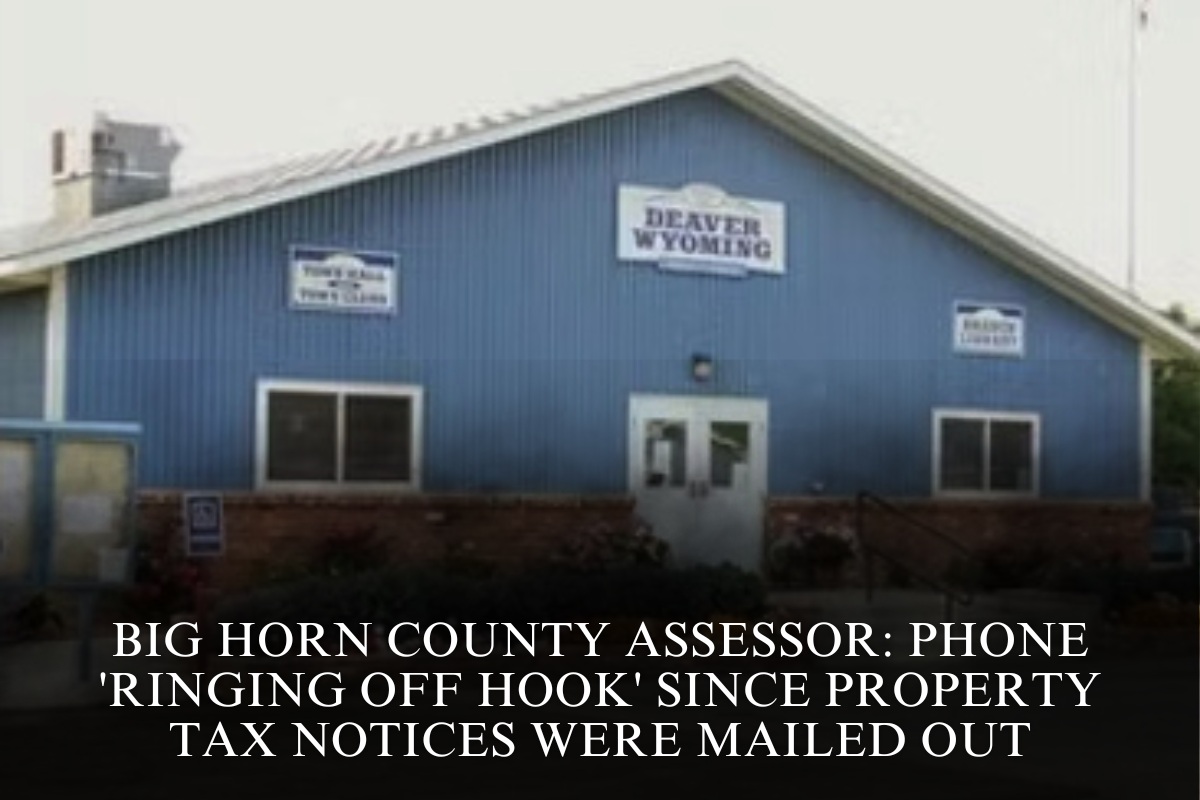CHEYENNE — From a distance, all of the Thunderbird F-16 Fighting Falcon planes appear to be identical, but one stands out.
That plane has the number “5” written upside down.
Maj. Jeffrey Downie, also known as “Simmer,” pilots the plane.
If you ask him why he uses that nickname, he’ll tell you it’s because the price is one beer. When you offer to pay that price, he will laugh and tell you that he does not drink beer. Some things in life simply cannot be understood by the outside world.
They include the Thunderbirds, as well as many of their inside pilot jokes.
There is one inside joke that Downie will explain without a beer. That is the upside-down number on his plane.
“So, it started as a joke about 36 years ago,” he told Cowboy State Daily, standing planeside shortly after landing in Cheyenne for another Wings Over Wyoming Airshow. “One of the crew chiefs turned the five upside down because the lead solo, which is my position, performs the majority of the air show maneuvers upside down.”
“That joke has persisted ever since. So I get to represent all of my brochures on the jet, as well as my uniform and autograph; I always put the five upside down.”
It’s similar to the old rodeo joke in which the cowboy says after his 8-second ride that he assumed he had gotten on his bull backwards because he never saw its head.
Downie laughs briefly, but then takes a serious tone, because flying with the Thunderbirds is no joke.
“I’ve never ridden a bull, and I have no desire to,” Downie stated. “But it can get a little bit bumpy in there.”
It’s not just a bumpy ride. It’s dangerous, with planes flying 18 inches apart at speeds greater than 500 mph. And the ride lasts much longer than eight seconds.
The Thunderbirds have been flying over Cheyenne for decades. The Thunderbirds’ connection to Wyoming dates back 72 years, to the 1953 Cheyenne Frontier Days, their first civilian air show. They have returned almost every year since, with the exception of two.
They Love The Challenge
Ask Downie if he’s one of the best pilots in the world, and he will demur.
“You have to be above average for sure on the flying side of the house,” he told me. “However, you do not have to be God’s gift to aviation. We are specifically looking for people who will represent the team and the brand, who are humble and approachable. That is exactly what we’re looking for.
But in the Netflix documentary “Air Force Elite: Thunderbirds,” which was released in May and which Downie helped to narrate, his voice is unequivocal about the status of the pilots who fly these highly maneuverable, multi-function planes known as Thunderbirds.
They are the world’s best pilots, and they intentionally fly on the edge of humanity’s capabilities. Their goal is shock and awe, which can help bring a nation together.
In the team’s more than 70-year history, twenty-one Thunderbird pilots have been killed, the majority of whom during training exercises. Three of them have undergone air shows.
“We get to a point where you’re kind of at the limit of human ability to absorb movement,” Downie told me. “And, you know, a lot of times it depends on the environmental turbulence we’re experiencing from buildings and terrain.
“Blacktop parking lots filled with massive columns of hot air. They have an impact on the jets’ ability and the smoothness of the air itself. So, any given day can be unique and challenging.”
The Thunderbirds can perform three different air shows: high, low, and flat.
“It depends on the height of the clouds,” Downie explained. “And then there’s certain, obviously, visibility requirements to be able to see the other aircraft as we’re pointing our noses at each other and passing at the very last second.”
Weather has a huge impact on what the show can do and, in some cases, prevents it from happening at all.
“High density altitude is a thing, especially here at the show at Cheyenne and F.E. Warren,” Downie told the crowd. “The aircraft bleeds energy a lot faster and it makes it very difficult for us.”
He pauses for a moment before adding, “But we always love a good challenge.”
Feel the Power of Jets in Your Body.
Saturday’s Wings Over Warren Airshow, which runs from 11 a.m. to noon, will feature six planes flying inches apart and performing what Downie described as a “plethora” of death-defying maneuvers for a 37-minute audience thrill.
Traditionally, the event was held midweek, but the performance was moved to Saturday in order to engage more people during their visit to Cheyenne Frontier Days.
The free public event, held directly next to Frontier Park, will feature food trucks, inflatable games, and static displays of Black Hawkand Huey helicopters.
“This is an incredible performance,” Downie stated. “It’s not just watching the jets. You’re part of the action. You can feel the power of these jets throughout your body.”
Four of the planes will form the diamond formation, while the other two will perform solo maneuvers during the show.
The purpose of having these two types of maneuvers is to demonstrate various things. Solo flights demonstrate the F-16 Fighting Falcon’s extreme capabilities in terms of speed, maneuverability, and performance limits. The diamond formation demonstrates the team’s precision and training.
Pilots rotate in and out of the Thunderbirds team on a regular basis, but they never change the type of plane they fly.
If they start out as diamond formation pilots, they will remain so. If they begin as solo pilots, they will remain so throughout their Thunderbirds career.
“You can’t just plug and play around,” Downie explained. “That’s because it’s so unique and highly specialized. There are no alternate pilots for this. We are the only people in the world who can fly our position during this demonstration.”
How They Bring The Jets Together
The diamond is the tightest flying formation that exists.
This formation, at only 18 inches apart and speeds exceeding 500 mph, requires steel nerves. It also takes something completely counterintuitive: blind trust.
Each pilot must fly their plane with the confidence that their copilots have precisely positioned themselves.
Anything less than that precision, and the entire diamond formation will crash and burn, killing all four pilots.
The key to this formation is training. They’ll start at typical fighter formation distances of 5 to 6 feet, then draw in closer and closer until they’re only 18 inches apart.
It’s incredible, given that 5 to 6 feet is already considered a difficult challenge.
“It’s very precise flying,” Downie said. “There are very small pressures on the stick and the controls. Flying even (5 to 6 feet apart) requires a high level of attention to detail and precision. And then we take it to the next level, making things tighter and tighter.”
During the diamond formation routines, the lead pilot aims his plane directly at the ground. It will crash if the companion plane does not slide into the exact right spot, giving the lead plane the extra lift it requires to stay exactly 100 feet above the ground.
The slightest movement of any one plane’s controls with human hands at this point can result in a four-jet collision, so the blind trust required for these maneuvers is not easily granted.
It is earned through days and days of nonstop team practice, where they not only learn but also expand their capabilities.
“Our training season starts the day after our very last show in November,” Downie informed us. “We’ll fly twice a day, every day, six days a week, sometimes seven, until March. We have five months to really hone our craft, and all we have to do is repeat ourselves day after day.
Dealing with maximum G-forces
The diamond ship’s signature maneuver is known as the high bomb burst. It is a difficult and dangerous maneuver that tests the limits of the g-force that humans can withstand.
G-force, also known as gravitational force, is a measurement of the effect of acceleration force on a stationary body, such as an airplane pilot. One “G” is equivalent to the normal gravity caused by the earth’s acceleration, which is 9.8 meters per second squared.
A force of 4 Gs is equivalent to four times gravity. That is most people’s resting tolerance.
A force of 8 Gs equals eight times gravity. At that point, a person weighing 200 pounds is more like 2,000 pounds, or nearly a ton.
Above 8 Gs, blood begins to drain from the skull, which can quickly lead to unconsciousness if not stopped.
“We pull a lot of Gs throughout the demonstration, as we’re turning and repositioning for the show,” Downie told the crowd. “Our target is approximately 7.5, and we try not to exceed it. But if we need it, it’s a 9 G-capable jet, so we’ll typically peak out at 8.5 Gs, which is a lot of pressure on your body.”
During the high-bomb maneuver, the four-ship diamond will pull straight up into a vertical position before splitting off in four directions, creating the appearance of white flower petals in the sky.
A solo, on the other hand, will climb 3 miles straight up while rolling, while the diamond formation planes will travel 3 miles in opposite directions before turning down and returning to the show’s center.
They close in on each other at speeds approaching 1,000 mph while only a few hundred feet above ground. Getting there means approaching the maximum G-force that each pilot can withstand.
You Hear Them Coming
You’ll hear the Thunderbirds long before you see them. It is the sound of raw power coming down to earth, cracking open the sky.
The sound begins as a low buzz and gradually increases, with white smoke pouring from the cracked seams of sound.
It represents only a fraction of the power available to these planes.
“I’ve done Mach 1.4,” Downie explained. “That is the fastest I’ve gone. Obviously, we cannot do that during an air show or at supersonic speeds because we would break a lot of windows. But that’s the fastest I’ve ever gone outside of that.
That kind of speed rarely provides a tactical advantage, Downie added, and it exposes the player to more g-forces, which can cause unconsciousness.
For Thunderbirds pilots, it’s always about pushing the limits, flying safely, and performing to the best of their abilities.
Downie regards his time with the Thunderbirds, which ends this year, as a high point in his life.
“Our mission as a recruiter can inspire,” he told me. “And that demonstration, that human achievement just makes you proud of being American as you watch.”
Every year, Thunderbirds return to Cheyenne Frontier Days because the show holds a special place in their history.
“Our history goes way back to our roots almost 72 years ago, doing our first show here for Cheyenne Frontier Days,” Downie recalled. “This was our first public display.
“We had previously performed at a military show site, but (CFD) was the Thunderbirds’ first civilian public display or performance. “It’s very special to us.”
But heritage isn’t the only thing that has kept the Thunderbirds returning to Cheyenne Frontier Days year after year, when they would normally only appear every other year.
When these pilots visit Wyoming and Cheyenne, they feel a deep appreciation for the places.
Major Patrick Gargan, a spokesperson for F.E. Warren, told Cowboy State Daily that this happens all the time in Cheyenne.
“I went out to the parade on Monday and just to see the community stand as some of the service members walked by, you could see the respect and the tradition is alive and well here in the community,” Gargan told Cowboy State Daily in an interview. “It’s really awesome to see and fun to be part of, to get to see it firsthand.”
Downie concurred with Gargan’s assessment.
“The people here in Cheyenne are just incredibly patriotic,” Downie told me. “And it’s fun to be appreciated in a city that is bleeding red, white and blue.”












